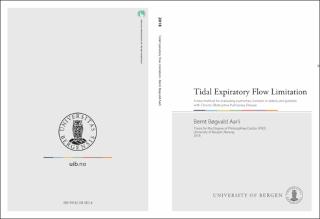| dc.contributor.author | Aarli, Bernt Bøgvald | en_US |
| dc.date.accessioned | 2018-03-26T09:19:16Z | |
| dc.date.available | 2018-03-26T09:19:16Z | |
| dc.date.issued | 2018-01-18 | |
| dc.identifier.isbn | 978-82-308-3855-6 | en_US |
| dc.identifier.uri | https://hdl.handle.net/1956/17548 | |
| dc.description.abstract | Background: Lung function declines with old age and is further accelerated by exposure to noxious particles. As our society ages, expected lifespan increases, and prevalence of chronic obstructive pulmonary disease (COPD) is on the rise. Spirometry is used both to diagnose and to grade the degree of airway obstruction, but many elderly fail to perform this procedure satisfactory. More tools are needed to evaluate this large patient group. The present study explores the use of forced oscillation technique (FOT) in healthy elderly and in a longitudinal case-control study of COPD patients and controls. Aims: • Generate reference values for FOT using impulse oscillations in healthy elderly. • Evaluate the agreement between two methods: sinusoidal pressure oscillations and impulse oscillations. • Evaluate variability of whole-breath and within-breath FOT measurements, examine factors influencing tidal expiratory flow limitation, and describe its impact on morbidity and mortality. Materials and Methods: regional ethics committees have approved all studies. In the first study, predictive equations were generated for FOT parameters in 75 subjects with normal spirometry who were drawn in an age and sex stratified sample from healthy, non-smoking responders of a health questionnaire in elderly, aged >70 years. The second study examined the agreement between sinusoidal pressure oscillations and impulse oscillations in 20 patients in a rehabilitation hospital. The final study followed 425 COPD and 229 controls over 3 years/8 visits with FOT and spirometry. Six-minute walk distance (6MWD) was assessed at baseline and at the final visit, respiratory symptoms, exacerbations, and hospitalizations were recorded, and mortality statistics retrieved retrospectively. Results: Reference values for whole-breath and within-breath FOT parameters were generated in healthy elderly. In non flow-limited patients, good agreement between sinusoidal and impulse pressure oscillations was found. Flow-limited patients had higher variability than the expected biological variability and significantly higher resistance values. Healthy controls had little variability in the FOT measurements. A higher variability was found in COPD patients. COPD patients with mean withinbreath reactance, ΔXrs >0.1 kPa·s·L-1 were more breathless. The upper limit of normal (ULN), defined at the 97.5 percentile of ΔXrs , in healthy controls was 0.09 kPa·s·L-1. COPD patients with Δ Xrs ≥ULN had a significant decline in 6MWD from baseline to the final visit, more exacerbations and more hospitalizations than COPD patients with ΔXrs in the normal range. COPD patients with FEV1 >50% and ΔXrs ≥ULN also had a significantly higher mortality. Conclusions: Reference equations generated in healthy elderly yielded higher resistance measurements than what was found when simply extrapolating existing reference equations generated in a younger population. When examining agreement between sinusoidal pressure oscillations and impulse oscillations, impulse oscillations overestimated resistance in patients with flow-limitation. We describe a new method to assess flow-limitation in COPD patients by averaging measurements over several breaths. The COPD patients with ΔXrs >0.1 kPa·s·L-1, just above the ULN were more likely to report dyspnea. ΔXrs ≥ULN in COPD was associated with a significant decline in 6MWD, more moderate and severe exacerbations, and in patients with moderate airway obstruction, a significantly higher mortality. | en_US |
| dc.language.iso | eng | eng |
| dc.publisher | The University of Bergen | eng |
| dc.relation.haspart | Paper I: Aarli BB, Eagan TM, Ellingsen I, Bakke PS, Hardie JA. Reference values for withinbreath pulmonary impedance parameters in asymptomatic elderly, Clin Respir J. 2013 Jul; 7(3): 245-52. The article is available in the main thesis. The article is also available at: <a href="https://doi.org/10.1111/j.1752-699X.2012.00312.x" target="blank">https://doi.org/10.1111/j.1752-699X.2012.00312.x</a> | en_US |
| dc.relation.haspart | Paper II: Aarli BB, Govani L, Pompilio PP, Simonetta Valdi, Hardie JA, Dellaca R. Agreement between sinusoidal and impulse oscillations when measuring pulmonary impedance. Full text not available in BORA. | en_US |
| dc.relation.haspart | Paper III: Aarli BB, Calverley PMA, Jensen RL, Eagan TM, Bakke PS, Hardie JA. Variability of within-breath reactance in COPD patients and its association with dyspnea. Eur Resp J. 2015. Mar; 45(3): 625-34. Full text not available in BORA due to publisher restrictions. The article is available at: <a href="http://dx.doi.org/10.1183/09031936.00051214" target="blank">http://dx.doi.org/10.1183/09031936.00051214</a> | en_US |
| dc.relation.haspart | Paper IV: Aarli BB, Calverley PMA, Jensen RL, R Dellaca, Eagan TM, Bakke PS, Hardie JA. The association of tidal EFL with exercise performance, exacerbations, and death in COPD: A COPD Cohort Study. International Journal of Chronic Obstructive Pulmonary Disease. 2017; 12:2179-2188. The article is available at: <a href="http://hdl.handle.net/1956/17547" target="blank">http://hdl.handle.net/1956/17547</a> | en_US |
| dc.title | Tidal Expiratory Flow Limitation. A new method for evaluating pulmonary function in elderly and patients with Chronic Obstructive Pulmonary Disease | en_US |
| dc.type | Doctoral thesis | |
| dc.rights.holder | Copyright the Author. All rights reserved | |
| dc.identifier.cristin | 1540508 | |
